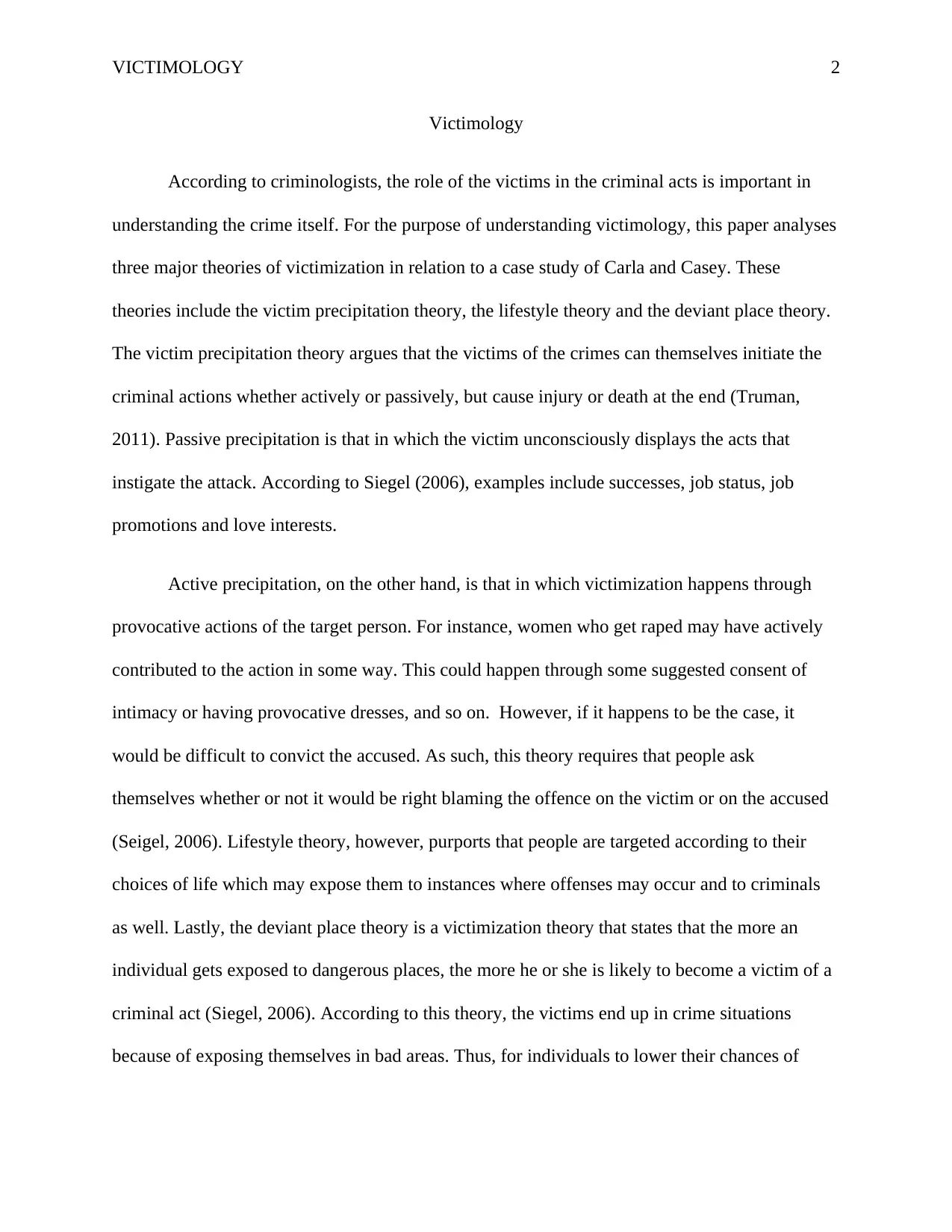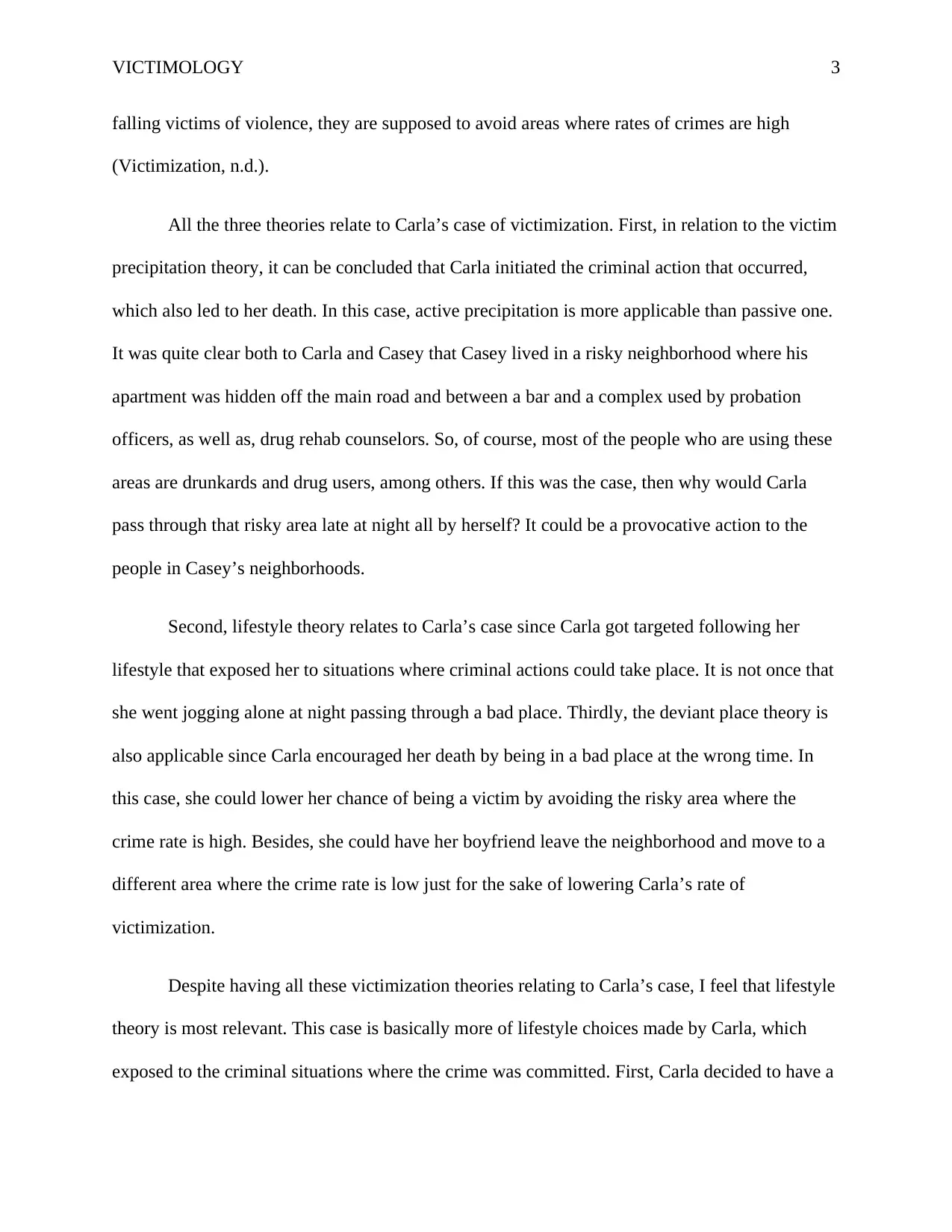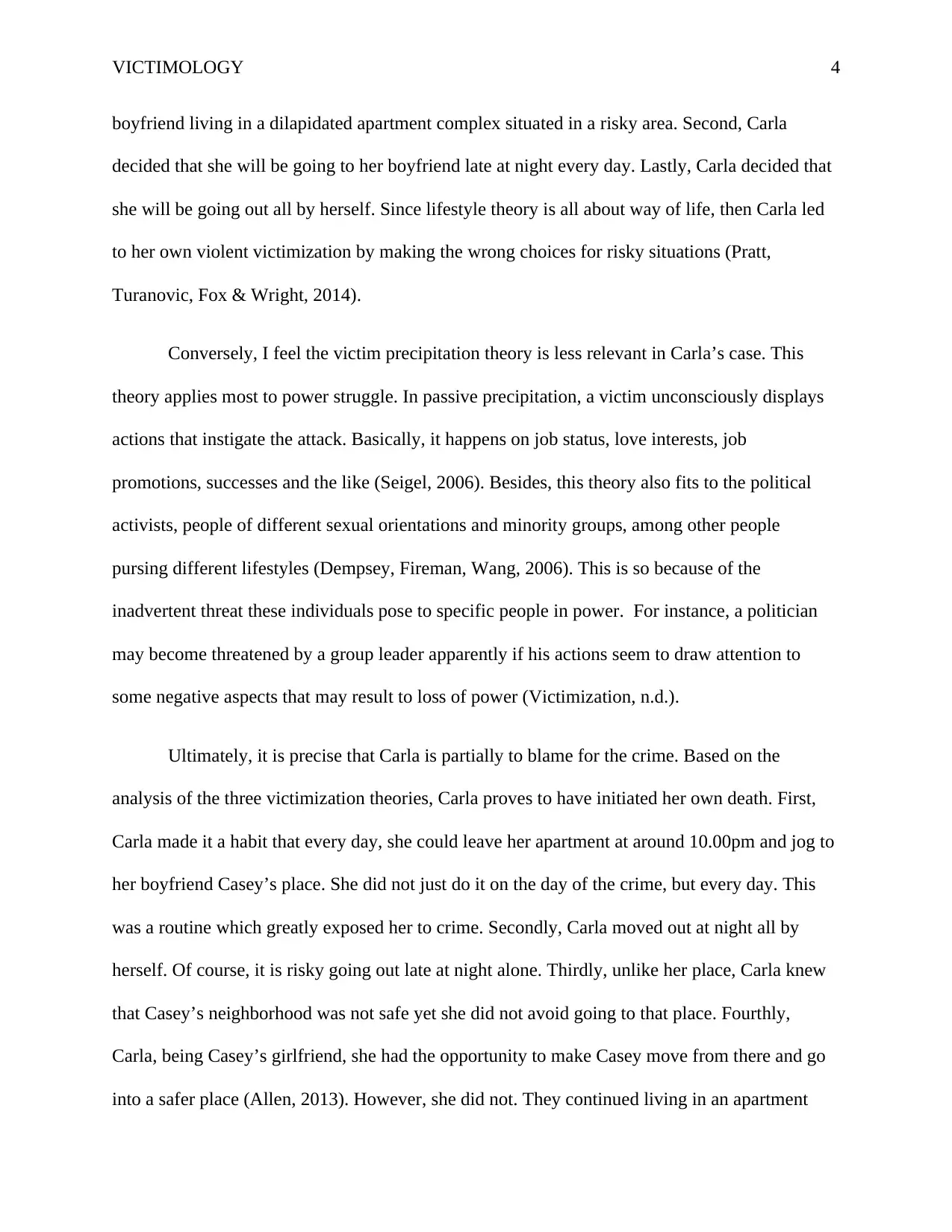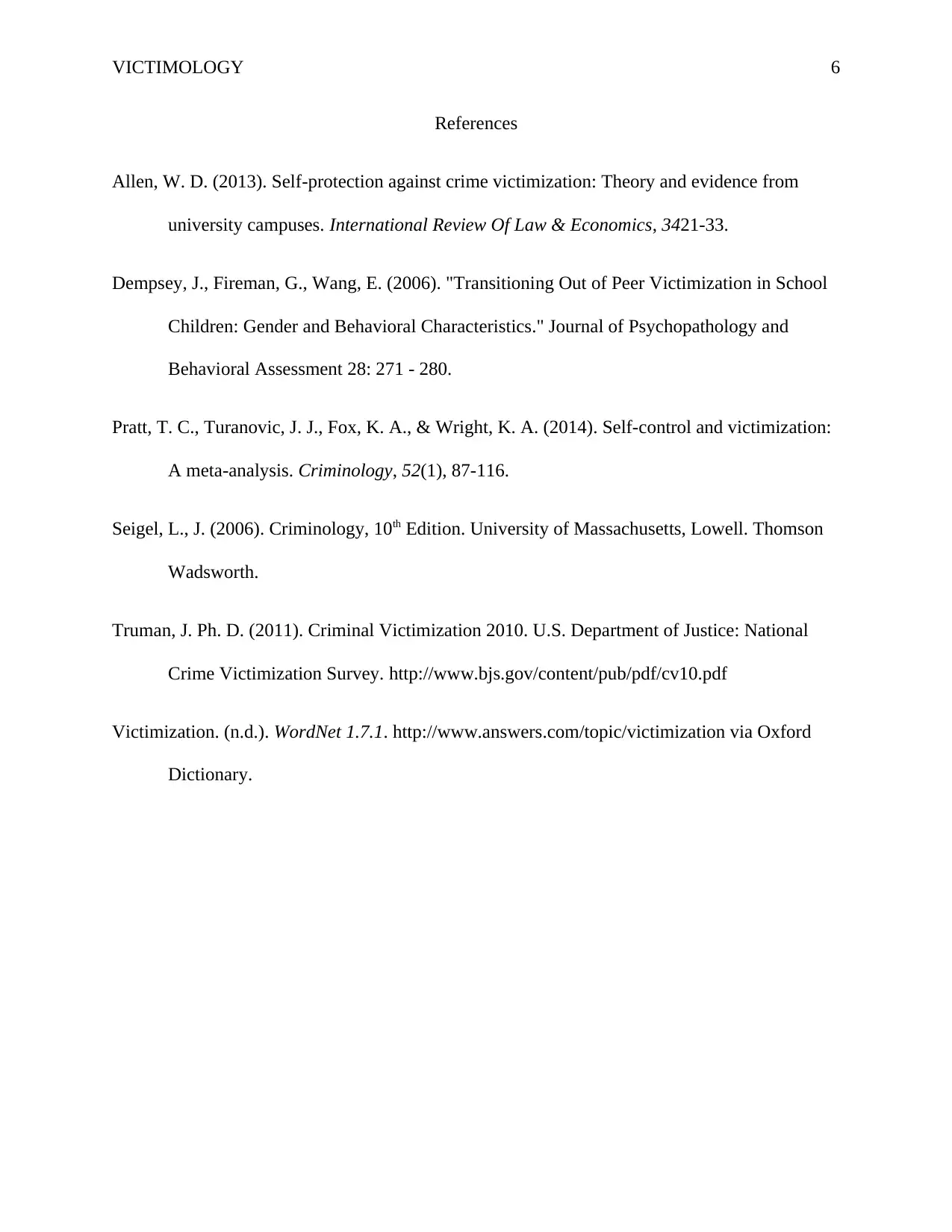Victimology Essay
VerifiedAdded on 2019/11/26
|6
|1385
|186
Essay
AI Summary
This essay examines three major theories of victimization—victim precipitation, lifestyle theory, and deviant place theory—in relation to a case study involving Carla and Casey. The victim precipitation theory suggests victims may actively or passively initiate criminal actions. The lifestyle theory posits that individuals' choices expose them to crime. The deviant place theory links victimization to exposure to high-crime areas. The essay applies these theories to Carla's case, concluding that her lifestyle choices significantly contributed to her victimization. While acknowledging the relevance of other theories, the essay emphasizes the lifestyle theory as the most applicable in this instance, highlighting Carla's risky behaviors and choices that increased her vulnerability to crime. The essay concludes that Carla's actions partially contributed to her death due to her repeated late-night journeys through a high-crime area and her failure to encourage her boyfriend to relocate to a safer neighborhood.

Running head: VICTIMOLOGY 1
Victimology
Name:
Institutional Affiliation:
Victimology
Name:
Institutional Affiliation:
Paraphrase This Document
Need a fresh take? Get an instant paraphrase of this document with our AI Paraphraser

VICTIMOLOGY 2
Victimology
According to criminologists, the role of the victims in the criminal acts is important in
understanding the crime itself. For the purpose of understanding victimology, this paper analyses
three major theories of victimization in relation to a case study of Carla and Casey. These
theories include the victim precipitation theory, the lifestyle theory and the deviant place theory.
The victim precipitation theory argues that the victims of the crimes can themselves initiate the
criminal actions whether actively or passively, but cause injury or death at the end (Truman,
2011). Passive precipitation is that in which the victim unconsciously displays the acts that
instigate the attack. According to Siegel (2006), examples include successes, job status, job
promotions and love interests.
Active precipitation, on the other hand, is that in which victimization happens through
provocative actions of the target person. For instance, women who get raped may have actively
contributed to the action in some way. This could happen through some suggested consent of
intimacy or having provocative dresses, and so on. However, if it happens to be the case, it
would be difficult to convict the accused. As such, this theory requires that people ask
themselves whether or not it would be right blaming the offence on the victim or on the accused
(Seigel, 2006). Lifestyle theory, however, purports that people are targeted according to their
choices of life which may expose them to instances where offenses may occur and to criminals
as well. Lastly, the deviant place theory is a victimization theory that states that the more an
individual gets exposed to dangerous places, the more he or she is likely to become a victim of a
criminal act (Siegel, 2006). According to this theory, the victims end up in crime situations
because of exposing themselves in bad areas. Thus, for individuals to lower their chances of
Victimology
According to criminologists, the role of the victims in the criminal acts is important in
understanding the crime itself. For the purpose of understanding victimology, this paper analyses
three major theories of victimization in relation to a case study of Carla and Casey. These
theories include the victim precipitation theory, the lifestyle theory and the deviant place theory.
The victim precipitation theory argues that the victims of the crimes can themselves initiate the
criminal actions whether actively or passively, but cause injury or death at the end (Truman,
2011). Passive precipitation is that in which the victim unconsciously displays the acts that
instigate the attack. According to Siegel (2006), examples include successes, job status, job
promotions and love interests.
Active precipitation, on the other hand, is that in which victimization happens through
provocative actions of the target person. For instance, women who get raped may have actively
contributed to the action in some way. This could happen through some suggested consent of
intimacy or having provocative dresses, and so on. However, if it happens to be the case, it
would be difficult to convict the accused. As such, this theory requires that people ask
themselves whether or not it would be right blaming the offence on the victim or on the accused
(Seigel, 2006). Lifestyle theory, however, purports that people are targeted according to their
choices of life which may expose them to instances where offenses may occur and to criminals
as well. Lastly, the deviant place theory is a victimization theory that states that the more an
individual gets exposed to dangerous places, the more he or she is likely to become a victim of a
criminal act (Siegel, 2006). According to this theory, the victims end up in crime situations
because of exposing themselves in bad areas. Thus, for individuals to lower their chances of

VICTIMOLOGY 3
falling victims of violence, they are supposed to avoid areas where rates of crimes are high
(Victimization, n.d.).
All the three theories relate to Carla’s case of victimization. First, in relation to the victim
precipitation theory, it can be concluded that Carla initiated the criminal action that occurred,
which also led to her death. In this case, active precipitation is more applicable than passive one.
It was quite clear both to Carla and Casey that Casey lived in a risky neighborhood where his
apartment was hidden off the main road and between a bar and a complex used by probation
officers, as well as, drug rehab counselors. So, of course, most of the people who are using these
areas are drunkards and drug users, among others. If this was the case, then why would Carla
pass through that risky area late at night all by herself? It could be a provocative action to the
people in Casey’s neighborhoods.
Second, lifestyle theory relates to Carla’s case since Carla got targeted following her
lifestyle that exposed her to situations where criminal actions could take place. It is not once that
she went jogging alone at night passing through a bad place. Thirdly, the deviant place theory is
also applicable since Carla encouraged her death by being in a bad place at the wrong time. In
this case, she could lower her chance of being a victim by avoiding the risky area where the
crime rate is high. Besides, she could have her boyfriend leave the neighborhood and move to a
different area where the crime rate is low just for the sake of lowering Carla’s rate of
victimization.
Despite having all these victimization theories relating to Carla’s case, I feel that lifestyle
theory is most relevant. This case is basically more of lifestyle choices made by Carla, which
exposed to the criminal situations where the crime was committed. First, Carla decided to have a
falling victims of violence, they are supposed to avoid areas where rates of crimes are high
(Victimization, n.d.).
All the three theories relate to Carla’s case of victimization. First, in relation to the victim
precipitation theory, it can be concluded that Carla initiated the criminal action that occurred,
which also led to her death. In this case, active precipitation is more applicable than passive one.
It was quite clear both to Carla and Casey that Casey lived in a risky neighborhood where his
apartment was hidden off the main road and between a bar and a complex used by probation
officers, as well as, drug rehab counselors. So, of course, most of the people who are using these
areas are drunkards and drug users, among others. If this was the case, then why would Carla
pass through that risky area late at night all by herself? It could be a provocative action to the
people in Casey’s neighborhoods.
Second, lifestyle theory relates to Carla’s case since Carla got targeted following her
lifestyle that exposed her to situations where criminal actions could take place. It is not once that
she went jogging alone at night passing through a bad place. Thirdly, the deviant place theory is
also applicable since Carla encouraged her death by being in a bad place at the wrong time. In
this case, she could lower her chance of being a victim by avoiding the risky area where the
crime rate is high. Besides, she could have her boyfriend leave the neighborhood and move to a
different area where the crime rate is low just for the sake of lowering Carla’s rate of
victimization.
Despite having all these victimization theories relating to Carla’s case, I feel that lifestyle
theory is most relevant. This case is basically more of lifestyle choices made by Carla, which
exposed to the criminal situations where the crime was committed. First, Carla decided to have a
⊘ This is a preview!⊘
Do you want full access?
Subscribe today to unlock all pages.

Trusted by 1+ million students worldwide

VICTIMOLOGY 4
boyfriend living in a dilapidated apartment complex situated in a risky area. Second, Carla
decided that she will be going to her boyfriend late at night every day. Lastly, Carla decided that
she will be going out all by herself. Since lifestyle theory is all about way of life, then Carla led
to her own violent victimization by making the wrong choices for risky situations (Pratt,
Turanovic, Fox & Wright, 2014).
Conversely, I feel the victim precipitation theory is less relevant in Carla’s case. This
theory applies most to power struggle. In passive precipitation, a victim unconsciously displays
actions that instigate the attack. Basically, it happens on job status, love interests, job
promotions, successes and the like (Seigel, 2006). Besides, this theory also fits to the political
activists, people of different sexual orientations and minority groups, among other people
pursing different lifestyles (Dempsey, Fireman, Wang, 2006). This is so because of the
inadvertent threat these individuals pose to specific people in power. For instance, a politician
may become threatened by a group leader apparently if his actions seem to draw attention to
some negative aspects that may result to loss of power (Victimization, n.d.).
Ultimately, it is precise that Carla is partially to blame for the crime. Based on the
analysis of the three victimization theories, Carla proves to have initiated her own death. First,
Carla made it a habit that every day, she could leave her apartment at around 10.00pm and jog to
her boyfriend Casey’s place. She did not just do it on the day of the crime, but every day. This
was a routine which greatly exposed her to crime. Secondly, Carla moved out at night all by
herself. Of course, it is risky going out late at night alone. Thirdly, unlike her place, Carla knew
that Casey’s neighborhood was not safe yet she did not avoid going to that place. Fourthly,
Carla, being Casey’s girlfriend, she had the opportunity to make Casey move from there and go
into a safer place (Allen, 2013). However, she did not. They continued living in an apartment
boyfriend living in a dilapidated apartment complex situated in a risky area. Second, Carla
decided that she will be going to her boyfriend late at night every day. Lastly, Carla decided that
she will be going out all by herself. Since lifestyle theory is all about way of life, then Carla led
to her own violent victimization by making the wrong choices for risky situations (Pratt,
Turanovic, Fox & Wright, 2014).
Conversely, I feel the victim precipitation theory is less relevant in Carla’s case. This
theory applies most to power struggle. In passive precipitation, a victim unconsciously displays
actions that instigate the attack. Basically, it happens on job status, love interests, job
promotions, successes and the like (Seigel, 2006). Besides, this theory also fits to the political
activists, people of different sexual orientations and minority groups, among other people
pursing different lifestyles (Dempsey, Fireman, Wang, 2006). This is so because of the
inadvertent threat these individuals pose to specific people in power. For instance, a politician
may become threatened by a group leader apparently if his actions seem to draw attention to
some negative aspects that may result to loss of power (Victimization, n.d.).
Ultimately, it is precise that Carla is partially to blame for the crime. Based on the
analysis of the three victimization theories, Carla proves to have initiated her own death. First,
Carla made it a habit that every day, she could leave her apartment at around 10.00pm and jog to
her boyfriend Casey’s place. She did not just do it on the day of the crime, but every day. This
was a routine which greatly exposed her to crime. Secondly, Carla moved out at night all by
herself. Of course, it is risky going out late at night alone. Thirdly, unlike her place, Carla knew
that Casey’s neighborhood was not safe yet she did not avoid going to that place. Fourthly,
Carla, being Casey’s girlfriend, she had the opportunity to make Casey move from there and go
into a safer place (Allen, 2013). However, she did not. They continued living in an apartment
Paraphrase This Document
Need a fresh take? Get an instant paraphrase of this document with our AI Paraphraser

VICTIMOLOGY 5
surrounded in a bad neighborhood. Therefore, if only Carla could avoid all these, then the crime
could not happen. Her behaviors contributed to her victimization because they caused her to put
herself at higher risk compared to if she had chosen a more conservative lifestyle.
surrounded in a bad neighborhood. Therefore, if only Carla could avoid all these, then the crime
could not happen. Her behaviors contributed to her victimization because they caused her to put
herself at higher risk compared to if she had chosen a more conservative lifestyle.

VICTIMOLOGY 6
References
Allen, W. D. (2013). Self-protection against crime victimization: Theory and evidence from
university campuses. International Review Of Law & Economics, 3421-33.
Dempsey, J., Fireman, G., Wang, E. (2006). "Transitioning Out of Peer Victimization in School
Children: Gender and Behavioral Characteristics." Journal of Psychopathology and
Behavioral Assessment 28: 271 - 280.
Pratt, T. C., Turanovic, J. J., Fox, K. A., & Wright, K. A. (2014). Self-control and victimization:
A meta-analysis. Criminology, 52(1), 87-116.
Seigel, L., J. (2006). Criminology, 10th Edition. University of Massachusetts, Lowell. Thomson
Wadsworth.
Truman, J. Ph. D. (2011). Criminal Victimization 2010. U.S. Department of Justice: National
Crime Victimization Survey. http://www.bjs.gov/content/pub/pdf/cv10.pdf
Victimization. (n.d.). WordNet 1.7.1. http://www.answers.com/topic/victimization via Oxford
Dictionary.
References
Allen, W. D. (2013). Self-protection against crime victimization: Theory and evidence from
university campuses. International Review Of Law & Economics, 3421-33.
Dempsey, J., Fireman, G., Wang, E. (2006). "Transitioning Out of Peer Victimization in School
Children: Gender and Behavioral Characteristics." Journal of Psychopathology and
Behavioral Assessment 28: 271 - 280.
Pratt, T. C., Turanovic, J. J., Fox, K. A., & Wright, K. A. (2014). Self-control and victimization:
A meta-analysis. Criminology, 52(1), 87-116.
Seigel, L., J. (2006). Criminology, 10th Edition. University of Massachusetts, Lowell. Thomson
Wadsworth.
Truman, J. Ph. D. (2011). Criminal Victimization 2010. U.S. Department of Justice: National
Crime Victimization Survey. http://www.bjs.gov/content/pub/pdf/cv10.pdf
Victimization. (n.d.). WordNet 1.7.1. http://www.answers.com/topic/victimization via Oxford
Dictionary.
⊘ This is a preview!⊘
Do you want full access?
Subscribe today to unlock all pages.

Trusted by 1+ million students worldwide
1 out of 6
Your All-in-One AI-Powered Toolkit for Academic Success.
+13062052269
info@desklib.com
Available 24*7 on WhatsApp / Email
![[object Object]](/_next/static/media/star-bottom.7253800d.svg)
Unlock your academic potential
Copyright © 2020–2025 A2Z Services. All Rights Reserved. Developed and managed by ZUCOL.